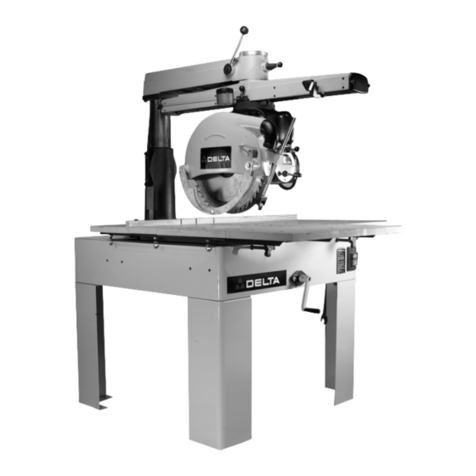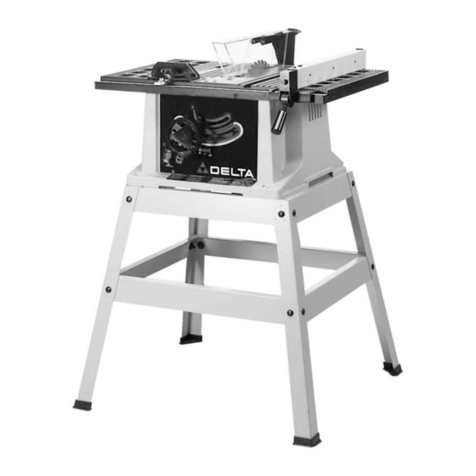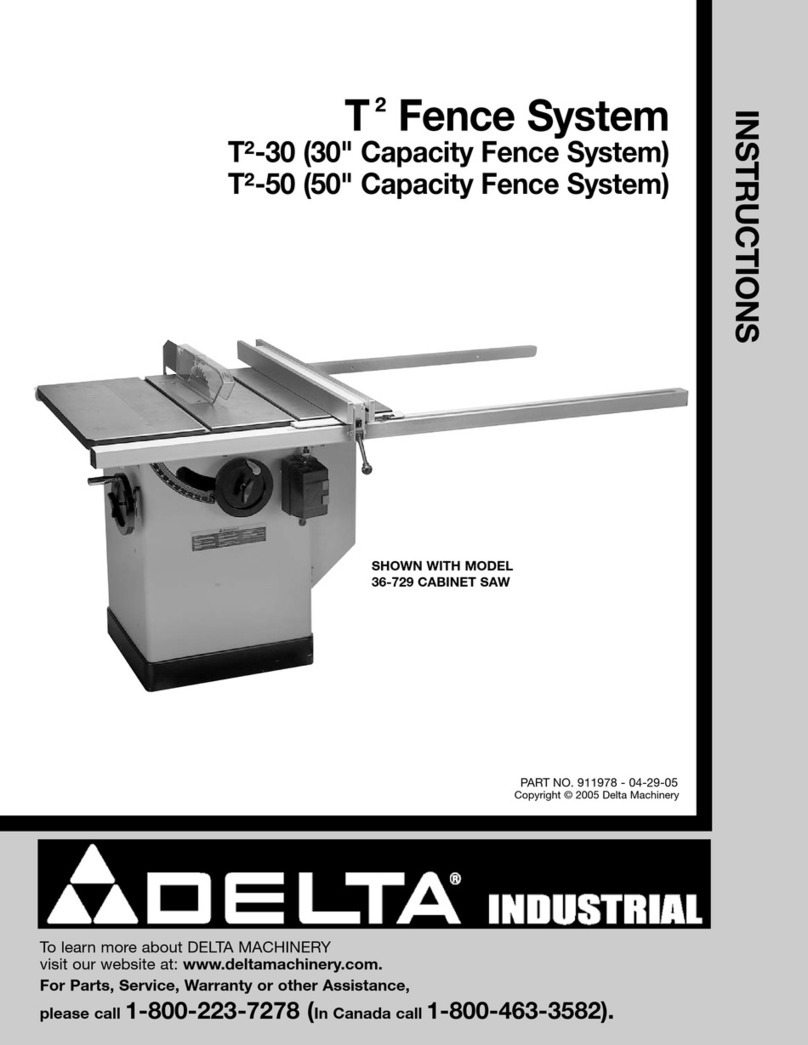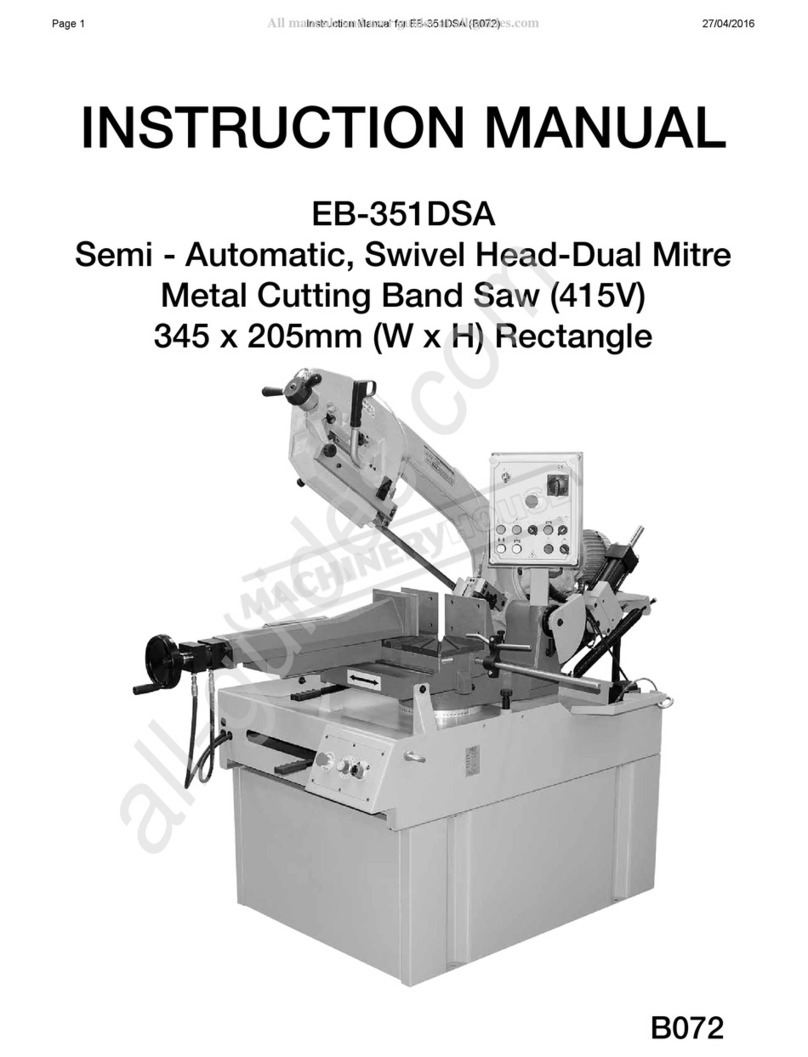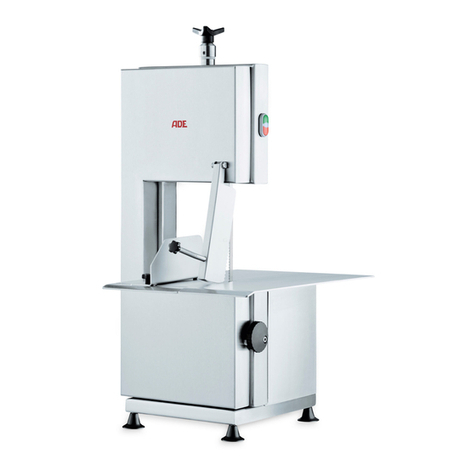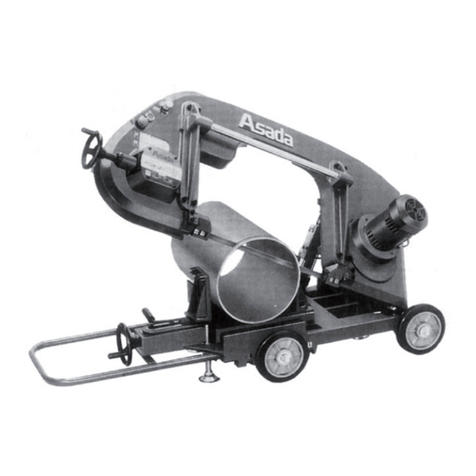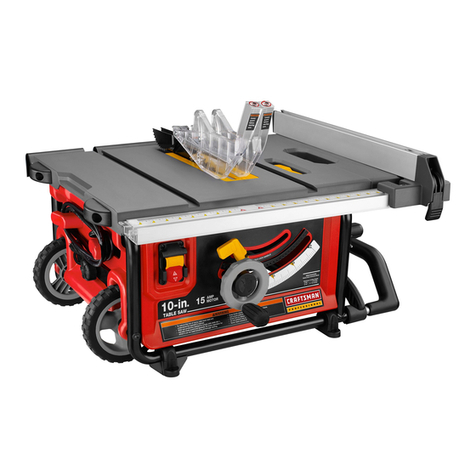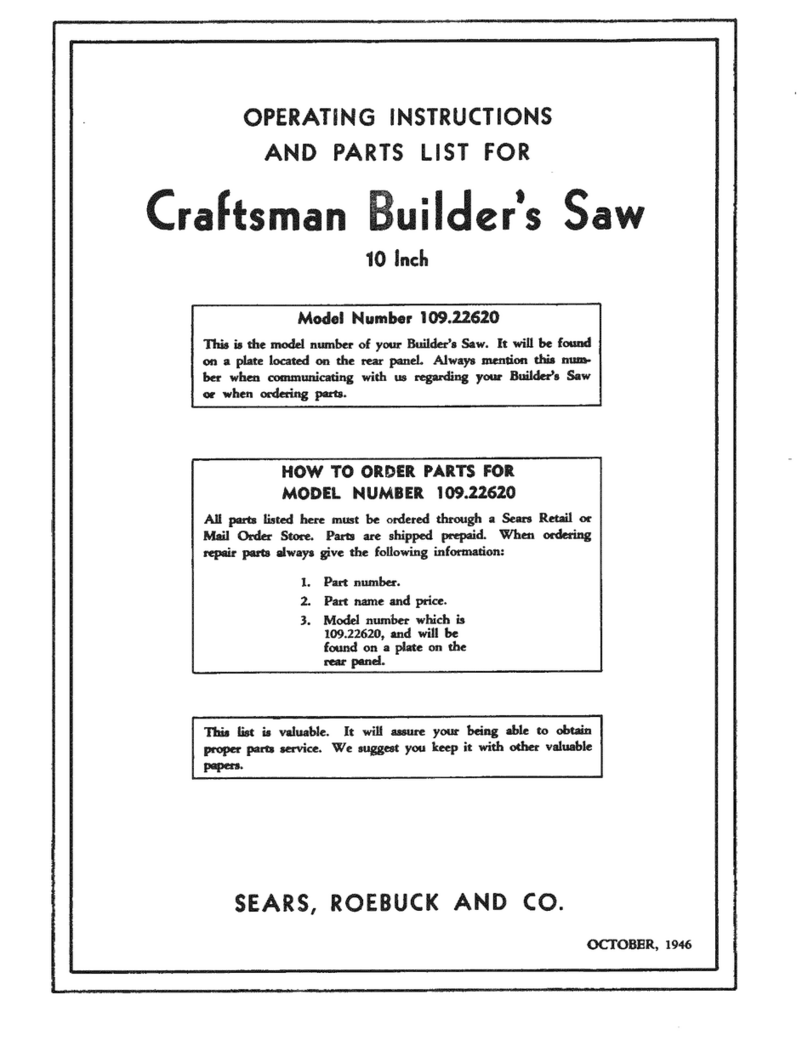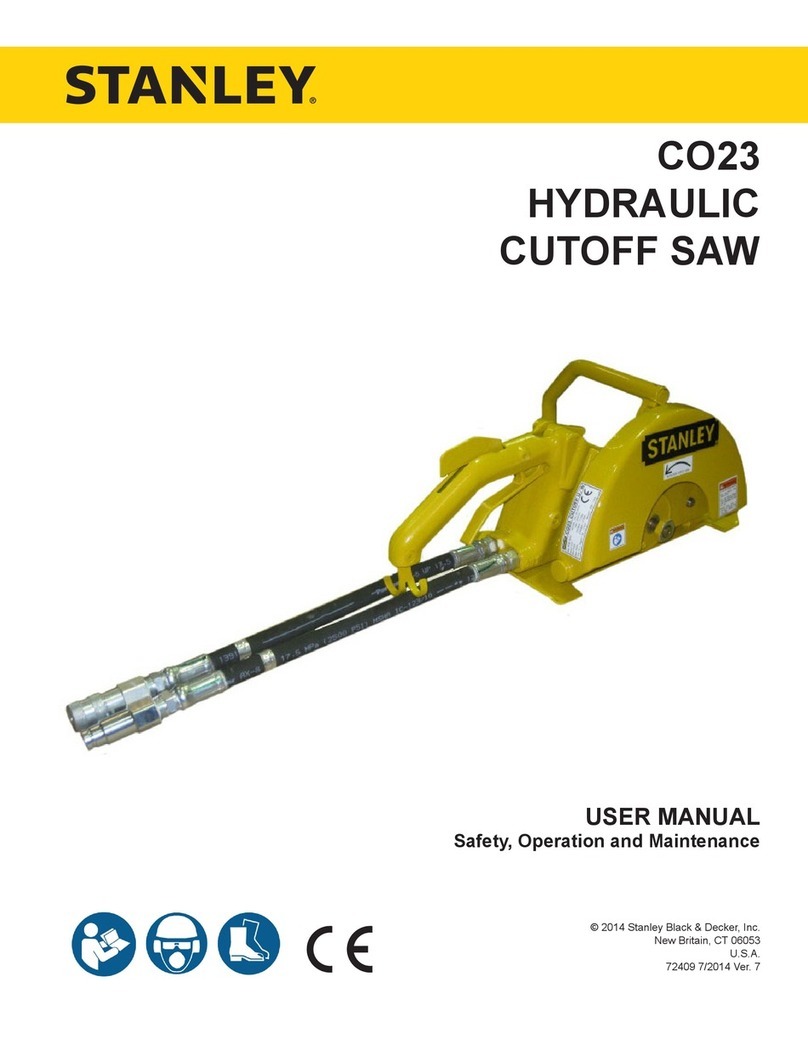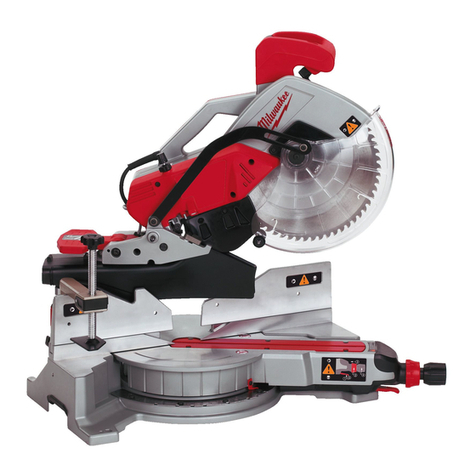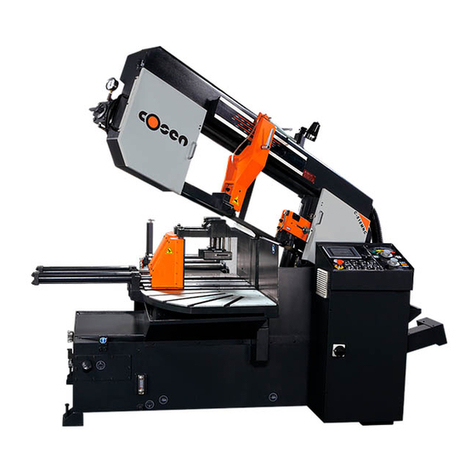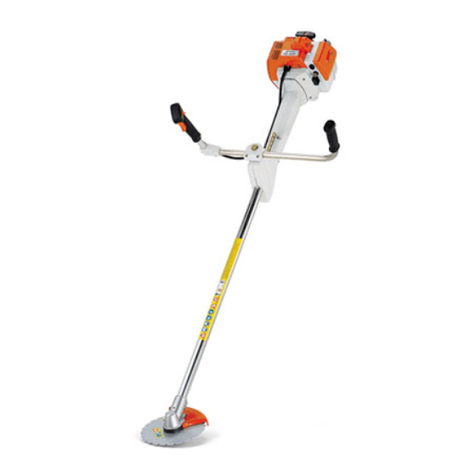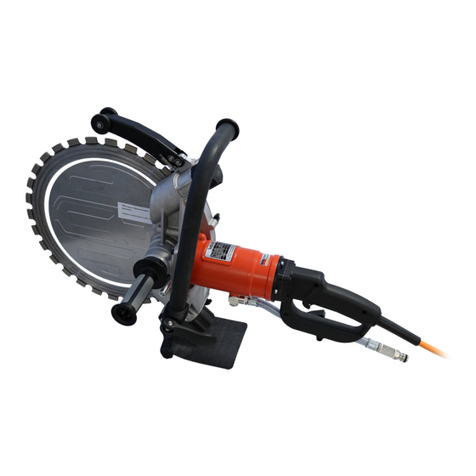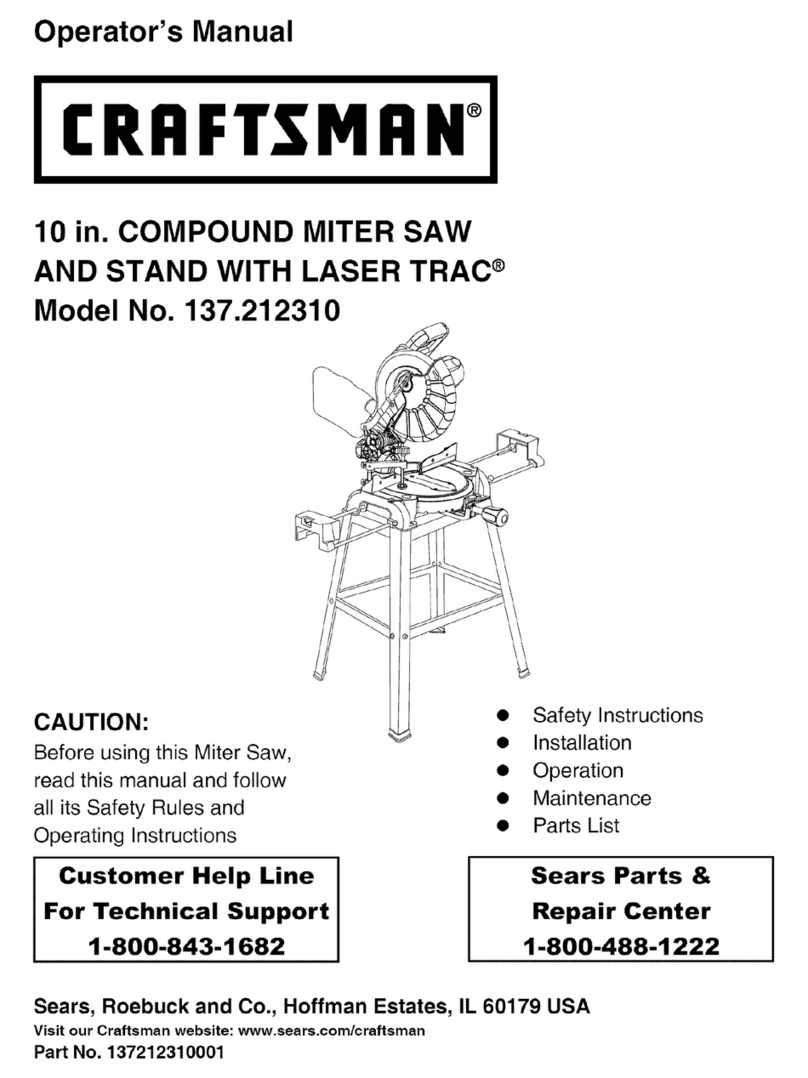Delta 36-477 User manual

INSTRUCTION MANUAL
REVISED 6-15-00 PART NO. 422-19-651-0045
Copyright © 2000 Delta Machinery
Platinum Edition
10" Contractor’s Saw
with 30" Unifence®
(Model 36-477)
with 30" Biesemeyer®
(Model 36-485)

2
SAFETY RULES
Woodworking can be dangerous if safe and proper operating procedures are not followed. As with all machinery, there are certain
hazards involved with the operation of the product. Using the machine with respect and caution will considerably lessen the possi-
bility of personal injury. However, if normal safety precautions are overlooked or ignored, personal injury to the operator may result.
Safety equipment such as guards, push sticks, hold-downs, featherboards, goggles, dust masks and hearing protection can reduce
your potential for injury. But even the best guard won’t make up for poor judgment, carelessness or inattention. Always use com-
mon sense and exercise caution in the workshop. If a procedure feels dangerous, don’t try it. Figure out an alternative procedure
that feels safer. REMEMBER: Your personal safety is your responsibility.
This machine was designed for certain applications only. Delta Machinery strongly recommends that this machine not be modified
and/or used for any application other than that for which it was designed. If you have any questions relative to a particular applica-
tion, DO NOT use the machine until you have first contacted Delta to determine if it can or should be performed on the product.
Technical Service Manager
Delta Machinery
4825 Highway 45 North
Jackson, TN 38305
(IN CANADA: 505 Southgate Drive, Guelph, Ontario N1H 6M7)
WARNING: FAILURE TO FOLLOW THESE RULES MAY RESULT IN SERIOUS PERSONAL
INJURY
1. FOR YOUR OWN SAFETY, READ INSTRUCTION
MANUAL BEFORE OPERATING THE TOOL. Learn the
tool’s application and limitations as well as the specific
hazards peculiar to it.
2. KEEP GUARDS IN PLACE and in working order.
3. ALWAYS WEAR EYE PROTECTION.
4. GROUND ALL TOOLS. If tool is equipped with three-
prong plug, it should be plugged into a three-hole electri-
cal receptacle. If an adapter is used to accommodate a
two-prong receptacle, the adapter plug must be attached
to a known ground. Never remove the third prong.
5. REMOVE ADJUSTING KEYS AND WRENCHES.
Form habit of checking to see that keys and adjusting
wrenches are removed from tool before turning it “on.”
6. KEEP WORK AREA CLEAN. Cluttered areas and
benches invite accidents.
7. DON’T USE IN DANGEROUS ENVIRONMENT.
Don’t use power tools in damp or wet locations, or
expose them to rain. Keep work area well-lighted.
8. KEEP CHILDREN AND VISITORS AWAY. All chil-
dren and visitors should be kept a safe distance from
work area.
9. MAKE WORKSHOP CHILDPROOF – with padlocks,
master switches, or by removing starter keys.
10. DON’T FORCE TOOL. It will do the job better and be
safer at the rate for which it was designed.
11. USE RIGHT TOOL. Don’t force tool or attachment to
do a job for which it was not designed.
12. WEAR PROPER APPAREL. No loose clothing,
gloves, neckties, rings, bracelets, or other jewelry to get
caught in moving parts. Nonslip footwear is recommend-
ed. Wear protective hair covering to contain long hair.
13. ALWAYS USE SAFETY GLASSES. Wear safety
glasses. Everyday eyeglasses only have impact resistant
lenses; they are not safety glasses. Also use face or dust
mask if cutting operation is dusty. These safety glasses
must conform to ANSI Z87.1 requirements. Note:
Approved glasses have Z87 printed or stamped on them.
14. SECURE WORK. Use clamps or a vise to hold work
when practical. It’s safer than using your hand and frees
both hands to operate tool.
15. DON’T OVERREACH. Keep proper footing and bal-
ance at all times.
16. MAINTAIN TOOLS IN TOP CONDITION. Keep tools
sharp and clean for best and safest performance. Follow
instructions for lubricating and changing accessories.
17. DISCONNECT TOOLS before servicing and when
changing accessories such as blades, bits, cutters, etc.
18. USE RECOMMENDED ACCESSORIES. The use of
accessories and attachments not recommended by Delta
may cause hazards or risk of injury to persons.
19. REDUCE THE RISK OF UNINTENTIONAL START-
ING. Make sure switch is in “OFF” position before plug-
ging in power cord.
20. NEVER STAND ON TOOL. Serious injury could occur
if the tool is tipped or if the cutting tool is accidentally con-
tacted.
21. CHECK DAMAGED PARTS. Before further use of
the tool, a guard or other part that is damaged should be
carefully checked to ensure that it will operate properly
and perform its intended function – check for alignment
of moving parts, binding of moving parts, breakage of
parts, mounting, and any other conditions that may affect
its operation. A guard or other part that is damaged
should be properly repaired or replaced.
22. DIRECTION OF FEED. Feed work into a blade or cut-
ter against the direction of rotation of the blade or cutter
only.
23. NEVER LEAVE TOOL RUNNING UNATTENDED.
TURN POWER OFF. Don’t leave tool until it comes to a
complete stop.
24. DRUGS, ALCOHOL, MEDICATION. Do not operate
tool while under the influence of drugs, alcohol or any
medication.
25. MAKE SURE TOOL IS DISCONNECTED FROM
POWER SUPPLY while motor is being mounted, con-
nected or re-connected.
26. WARNING: The dust generated by certain woods
and wood products can be injurious to your health.
Always operate machinery in well ventilated areas and
provide for proper dust removal. Use wood dust collec-
tion systems whenever possible.
27. WHEN THE UNIT IS NOT IN USE the switch should
be locked in the “OFF” position to prevent unauthorized
use.

3
ADDITIONAL SAFETY RULES FOR CIRCULAR SAWS
1. ALWAYS use blade guard and splitter with anti-
kickback for every operation for which it can be used,
including “thru-sawing” operations. Thru-sawing opera-
tions are those when the blade cuts completely through the
workpiece as in ripping or cross-cutting.
2. ALWAYS hold the work firmly against the miter gage
or fence.
3. ALWAYS use a push stick for ripping narrow stock.
Refer to ripping applications in instruction manual where
the push stick is covered in detail. See push stick pattern
included in this instruction manual.
4. NEVER perform any operation “free-hand” which
means using your hands to support or guide the work-
piece. Always use either the fence or miter gage to posi-
tion and guide the work.
5. NEVER stand or have any part of your body in line
with the path of the saw blade. KEEP your hands out of
the line of the saw blade.
6. NEVER reach behind or over the cutting tool with
either hand for any reason.
7. MOVE the rip fence out of the way when cross-
cutting.
8. NEVER use the fence as a cut-off gage when cross-
cutting.
9. DIRECTION OF FEED. Feed work into a blade or
cutter against the direction or rotation of the blade or
cutter only.
10. WHEN cutting moulding, NEVER run the stock be-
tween the fence and the moulding cutterhead.
11. NEVER attempt to free a stalled saw blade without
first turning the saw OFF. Turn off switch immediately to
prevent motor damage.
12. THE USE of attachments and accessories not
recommended by Delta may result in risk of injuries.
13. PROVIDE adequate support to the rear and sides of
the saw table for wide or long workpieces.
14. AVOID kickbacks (work thrown back toward you) by:
A. Keeping blade sharp.
B. Keeping rip fence parallel to the saw blade.
C. Keeping splitter and anti-kickback fingers and
guard in place and operating.
D. Not releasing the work before it is pushed all the
way past the saw blade.
E. Not ripping work that is twisted or warped or
does not have a straight edge to guide along
the fence.
15. AVOID awkward operations and hand positions
where a sudden slip could cause your hand to move into
the cutting tool.
16. NEVER use solvents to clean plastic parts. Solvents
could possibly dissolve or otherwise damage the material.
Only a soft, damp cloth should be used to clean plastic
parts.
17. PERMANENTLY mount the saw to a supporting sur-
face before performing any cutting operations.
18. NEVER cut metals or material which may make
hazardous dust.
19. ALWAYS. use in a well-ventilated area. Remove saw-
dust frequently. Clean out sawdust from the interior of the
saw to prevent a potential fire hazard.
20. DO NOT expose your saw to rain or use in a damp
location.
21. ADDITIONAL INFORMATION regarding the safe
and proper operation of this product is available from the
National Safety Council, 1121 Spring Lake Drive, Itasca,
IL 60143-3201, in the Accident Prevention Manual for
Industrial Operations and also in the Safety Data Sheets
provided by the NSC. Please also refer to the American
National Standards Institute ANSI 01.1 Safety Require-
ments for Woodworking Machinery and the U.S. Depart-
ment of Labor OSHA 1910.213 Regulations.
22. SAVE THESE INSTRUCTIONS. Refer to them fre-
quently and use them to instruct others.
FOREWORD
Delta 10 Contractor’s Saws are designed to give high quality performance with maximum depth of cut capacity up to
3-1/8 at 90° and 2-1/8 at 45° for clean cutting of standard stock sizes. Delta Model 36-477 includes a 30 Unifence
T-Slot rail fence system and Model 36-485 includes a 30 Biesemeyer T-Square home shop fence system. These Delta
Models come equiped with; basic machine, sturdy steel stand, integral dust chute, patented Auto-Set T-Slot miter
gage, heavy duty motor, large on/off paddle switch, cast extension wing and table, convenient up-front blade raising
and tilting controls and 10 carbide blade.
28. WARNING: SOME DUST CREATED BY POWER SANDING, SAWING, GRINDING, DRILLING, AND OTHER CON-
STRUCTION ACTIVITIES contains chemicals known to cause cancer, birth defects or other reproductive harm. Some
examples of these chemicals are:
• lead from lead-based paints,
• crystalline silica from bricks and cement and other masonry products, and
• arsenic and chromium from chemically-treated lumber.
Your risk from these exposures varies, depending on how often you do this type of work. To reduce your exposure to
these chemicals: work in a well-ventilated area, and work with approved safety equipment such as those dust masks
that are specially designed to filter out microscopic particles.
SAVE THESE INSTRUCTIONS

4
UNPACKING AND CLEANING
Carefully unpack the table saw and all loose items from the shipping containers. Remove the protective coating
from the machined surfaces of the saw. This coating may be removed with a soft cloth moistened with kerosene
(do not use acetone, gasoline or lacquer thinner for this purpose). Fig. 2, illustrates the components of the table
saw. Fig. 3, illustrates the components of the saw stand. Fig. 4, illustrates the components of the Unifence®Fig. 5,
6 and 7 illustrates the components of the Biesemeyer Fence.
1. Contractor’s Saw
2. Blade Tilting Handwheel
3. Handwheel Lock Knob
4. Blade Guard and Splitter Assembly
5. Table Insert
6. Miter Gage
7. Miter Gage Handle
8. Miter Gage Handle Cap
9. Splitter Mounting Bracket
10. 1/4-20 x 3/4 Hex Head Screws (2)
11. 1/4 Flat Washers (2)
12. 5/16-18 x 5/8 Carriage Head Screw
13. 5/16 Flat Washer
14. 5/16-18 Hex Nut
15. Arbor Wrenches (2)
16. Cast Iron Extension Table
17. 7/16-20 x 1-3/4 Hex Head Screws
for assembling extension table (3)
18. Flat Washers for assembling
extension wing (3)
19. 1/4-20 x 3/4 Flat head Screw
20. Flat Washer
21. Hex Nut
Fig. 2
1
6
2
3
5
7
8
9
11
10
14
13
12
15
18
17
16
21 20
19
4

5
1. Combination Dust Chute/
Support Panel
2. Motor Pulley
3. Motor
4. Pulley Guard
5. Drive Belt
6. Spring
7. Pins (2) for Mounting Motor
8. Motor Mounting Plate
9. Lockwashers (4)
10. Flat Washers (4)
11. 5/16-18 x 3/4 Carriage
Head Screws (4)
12. Hex Nuts (4)
13. 5/16 Hex Nuts (8)
14. 5/16 Lockwashers (8)
15. 5/16 Flat Washers
16. 5/16-18 x 5/8 Hex Head
Screws (8)
17. Rubber Feet (4)
18. #10-32 x 12 Screws (8)
19. #10 Keps Nuts (8)
20. #10-1/2 Sheet Metal
Screws (3)
21. Grommet
22. Front Leg Panel
23. Rear Leg Panel
1. Unifence Body
2. Fence
3. Shelf Support Bracket
4. Front Table Support
5. Table Board
6. Table Legs (2)
7. Front T-Slot Guide Rail
8. Leg Adapter (2)
9. Nuts and Flat Washers (2)
10. Leveling Screws (2)
11. Z-Brackets (3)
12. 7/16-20 x 3/4 Hex Head
Screws, Lockwashers,
and Flat Washers (3 ea.)
13. U-Bolts (2)
14. Angle Brackets (3)
15. 1/4-20 x 3/4 Carriage Head
Screws, Flat Washers, and
1/4-20 Hex Nuts (3 ea.)
16. Flat Washers and 1/4-20
Hex Nuts for U-Bolts (4 ea.)
17. #8 x 13/16 Hex Washer
Head Screws (14)
18. 3/8-24 x 1 Hex Head Bolts
Flat Washers, and Hex Nuts
(2 ea.)
19. 1/4-20 Hex Head Bolt, Flat
Washer and Hex Nut (1 ea.)
20. Guide Rail End Caps (2 ea.)
21. Unifence Flip Stop
Fig. 3
UNIFENCE T-SLOT RAIL FENCE SYSTEM
Fig. 4
21
22
20
18
19 17
16
15
14
12
10
13
11
9
7
8
6
5
4
3
2
1
23
6
7
10
9
8
12
15
14
13
16
17
18
19
20
1
2
3
4
5
11
21

6
BIESEMEYER T-SQUARE FENCE SYSTEM
The T-Square®Commercial Fence System includes the fence assembly, front rail, rear rail, front
guide tube and right extension table Model 78-927 for 30 capacity.
IMPORTANT: The T-Square®Fence System is designed to be used ONLY with a supporting
extension table.
UNPACKING
Carefully unpack the T-Square®fence system from the shipping carton(s). Figure 5, 6 & 7
illustrates all the items supplied with the 78-904 fence system.
1 - Rear Rail
2 - Front Rail
3 - Guide Tube
4 - T-Square®Fence Assembly
5 - Template for aligning front rail to saw table
for fastening guide tube to front rail
6 - 1/4-20 x 1/2 long hex head screws (7)
7 - Lock washers (7)
for fastening rear rail to saw table and sheet metal
extension wing if applicable
8 - 3/8-24 x 1-1/4 long hex head cap screws (2)
9 - 7/8 O.D. flat washers (2)
10 - Lock washers (2)
11 - 3/8-24 hex nuts (2)
for fastening front rail to saw table
12 - 3/8-16 x 1-1/4 long flat head screws (2)
13 - 7/8 O.D. flat washers (2)
14 - Lock washers (2)
15 - 3/8-16 hex nuts (2)
for fastening front and rear rails
to right extension table
16 - 1-1/2 long flat head Phillips screws (8)
17 - 1-1/4 O.D. Flat Washers (6)
18 - 1/4-20 hex nuts (8)
19 - Extension Table
for fastening extension table legs
20 - Legs (2)
21 - 5/8 long wood screws #8 (8)
22 - 1/4-20 x 1-1/2 long flat head
Phillips screws (4)
23 - 1/4 flat washers (4)
24 - 1/4-20 hex nuts (4)
NOTE: A common hardware package is used
for several different models, therefore you may
have leftover hardware.

7
Fig. 5
Fig. 6
1
2
3
4
5
6
7
8
9
10
16
17 18
11
15
14
13
12
19

8
Fig. 7
20
21
22
23
24

9
ASSEMBLY INSTRUCTIONS
Fig. 8
Fig. 9
Fig. 10
ASSEMBLING SAW STAND
1. Assemble the dust chute and support panel (A)
Fig. 8, to the inside of the front stand panel (B) with three
#10 x 1/2 sheet metal screws (C), four #10-32 x 1/2
screws (D), and four hex nuts (E). Fig. 9 illustrates the
dust chute and support panel (A) assembled to the front
of stand (B). NOTE: The front stand panel will have the
saw identity labels facing you. Do not completely tight-
en the stand hardware at this time. Also, make certain
the dust chute/support panel (A) Fig. 9, is located under
the lip of front stand panel (B).
2. Assemble the other end of dust chute and support
panel (A) Fig. 10, to rear stand panel (F) as shown with
four #10-32 x 1/2 screws and hex nuts, three of which
are shown at (D). NOTE: Do not completely tighten stand
hardware at this time.
B
C
E
D
A
A
B
A
D
D
F

10
Fig. 12
Fig. 13
Fig. 14
ASSEMBLING
SAW TO STAND
1. Fig. 11, illustrates the stand (B) completely assem-
bled.
2. Assemble rubber foot (A) Fig. 11, onto the end of
each stand leg (B). Insert grommet (C) into hole (D) in
stand leg.
3. Carefully place saw (E) Fig. 12, onto saw stand (B).
Align eight holes in the top of stand (B) with mounting
holes in the bottom of saw (E) and fasten with eight
screws, flat washers, lockwashers, and hex nuts (F) Fig.
11.
4. Fig. 12, illustrates the saw (E) assembled to the saw
stand (B). Carefully push down on the top of the saw
until the stand legs are positioned firmly on the floor sur-
face and securely tighten all saw and stand mounting
hardware. Notice that panel (G) is not only a support for
a stand, but also serves as a dust chute.
ASSEMBLING BLADE
TILTING HANDWHEEL
1. Assemble blade tilting handwheel (A) Fig. 13, to
shaft (B). Make certain slot (C) in handwheel is engaged
with roll pin (D) on the shaft.
2. Thread locking lever (E) Fig. 14, onto shaft.
3. Fig. 14, illustrates the blade tilting handwheel (A)
and locking lever (E) assembled to the saw.
E
B
G
DB
AC
A
E
Fig. 11
D
B
C
A
E
F

11
MOTOR
The motor shipped with your saw is a 1-1/2 H.P., Ball Bearing, Capacitor Start/Capacitor Run, 115/230
Volt motor.
This motor has been specially selected to best supply power to your machine and the relative safety
of the machine is enhanced by its use. We, therefore, strongly suggest that only this motor be used,
as the use of other motors may be detrimental to the performance and safety of the saw.
Fig. 15
Fig. 18Fig. 17
ASSEMBLING MOTOR TO
MOTOR MOUNTING PLATE
WARNING: WHEN ASSEMBLING THE MOTOR TO
THE MOTOR MOUNTING PLATE, MAKE CERTAIN THE
SAW IS DISCONNECTED FROM THE POWER
SOURCE.
1. Assemble the motor (A) to the motor mounting plate
(B) as shown in Fig. 15, using four carriage bolts, flat
washers, star washers, and hex nuts (C).
NOTE: Do not completely tighten the hex nuts at this
time.
ASSEMBLING MOTOR
AND MOTOR MOUNTING
PLATE TO SAW
WARNING: WHEN ASSEMBLING THE MOTOR AND
MOTOR MOUNTING PLATE TO THE SAW, MAKE
CER-TAIN THE SAW IS DISCONNECTED FROM THE
POWER SOURCE.
1. Insert two pins (X) Fig. 16, into holes (D) in each side
of bracket (B). Assemble spring (Y) onto ends of pins as
shown.
2. Position motor and motor mounting plate (A) Fig. 17,
below bracket (B) to allow bracket arm to slide through
large opening in motor mounting plate (A).
3. Depress plungers (C) Fig. 17, on both sides of
brack-et (B) and rotate motor mounting plate (A) until
plungers (C) are engaged in holes (D) Fig. 16, of motor
mounting plate (A).
A
C
B
B
D
A
C
B
C
A
Fig. 16
4. Fig. 18, illustrates the motor and motor mounting
plate assembled to the rear of the saw.
X
Y
X

12
Fig. 19
Fig. 20
Fig. 21
Fig. 22
ASSEMBLING MOTOR
PULLEY, BELT AND
PULLEY GUARD, AND
DRIVE BELT
WARNING: WHEN ASSEMBLING MOTOR PULLEY,
BELT AND PULLEY GUARD, AND DRIVE BELT, MAKE
CERTAIN THE MOTOR IS DISCONNECTED FROM
THE POWER SOURCE.
1. Remove the motor shaft key that is taped to the
motor.
2. Insert the key (A) Fig. 19, in the keyway on the motor
shaft. Assemble the motor pulley (B) on the motor shaft
as shown, with the hub of the pulley facing out. Tighten
set screw (C) against key (A) in motor shaft.
3. Remove wing nut and external tooth lockwasher (D)
Fig. 20, and outer cover (E) from belt and pulley guard (G).
4. Slide the belt and pulley guard bracket (G) Fig. 21,
between the motor plate (M) and motor mounting plate
(L), as shown.
5. Position belt and pulley guard bracket (G) Fig. 22, so
the motor pulley (B) is centered and through the hole in
the belt and pulley guard bracket, as shown. Tighten the
four hex nuts that fasten the motor to the motor mount-
ing plate.
6. Using a straight edge, align the motor pulley with the
arbor pulley. If necessary, adjust the motor pulley (B)
Fig. 22, in or out on the motor shaft.
B
A
C
GD
E
M
L
G
G
B

13
Fig. 23
Fig. 24
Fig. 25
Fig. 26
7. Lift the motor and assemble the drive belt (H) Fig.
23, to the arbor pulley and motor pulley (B). The weight
of the motor will provide the correct belt tension.
8. WARNING: IMMEDIATELY AFTER ASSEMBLING
THE BELT, RAISE THE SAW BLADE TO ITS MAXIMUM
HEIGHT AND TILT THE SAW BLADE TO 45 DEGREES.
CHECK TO SEE IF THE MOTOR (J) FIG. 24, IS BELOW
THE TOP OF THE TABLE SURFACE (K). IF THE
MOTOR (J) IS ABOVE THE TOP OF THE TABLE SUR-
FACE, THE MOTOR MUST BE MOVED TO THE LEFT
UNTIL YOU ARE CERTAIN THE END BELL (J) OF THE
MOTOR IS BELOW THE TOP OF THE TABLE SUR-
FACE. THEN RE-ALIGN THE MOTOR PULLEY TO THE
ARBOR PULLEY.
9. Assemble the outer cover (E) Fig. 25, of the belt and
pulley guard assembly, which was removed in STEP 3,
and fasten with external tooth lockwasher and wing nut
(D). IMPORTANT: Make certain the outer cover does not
interfere with the drive belt and the motor pulley.
CONNECTING MOTOR CORD
TO SWITCH ASSEMBLY
WARNING: BEFORE CONNECTING MOTOR CORD TO
THE SWITCH ASSEMBLY, MAKE CERTAIN THE SAW
IS DISCONNECTED FROM THE POWER SOURCE.
1. Insert the pronged motor plug (A) Fig. 26, into the
female receptacle (B) of switch-to-motor cord (C).
H
B
K
J
D
E
C
B
A

14
Fig. 27
Fig. 28
Fig. 29
Fig. 30
2. Fig. 27, illustrates the motor cord connected to the
switch assembly.
ASSEMBLING
BLADE GUARD AND
SPLITTER ASSEMBLY
WARNING: MAKE CERTAIN THE SAW IS DISCON-
NECTED FROM THE POWER SOURCE.
1. Fasten the rear splitter mounting bracket (A) Fig. 28,
to the rear trunnion using the two 3/4 hex head screws
(B) and flat washers. Do not completely tighten the two
screws (B) at this time.
2. With wrenches supplied, remove the saw blade from
the saw. Refer to section “CHANGING THE SAW BLADE”
of this manual. Raise saw arbor to its highest position.
3. Remove screw and large washer (C) Fig. 29, from
the inside splitter mounting bracket.
4. Using a straight edge, check to see if the top and
bottom of the inside splitter bracket (D) Fig. 30, is
aligned with the inner arbor flange (E), as shown.
BA
C
D
E

15
Fig. 31
Fig. 32
Fig. 33
Fig. 34
5. If an alignment is necessary, loosen the two screws
(F) Fig. 31, align bracket (D) with the arbor flange (E) and
tighten screws (F).
6. Loosely assemble large washer and screw (C) Fig. 31,
to the inside splitter bracket. This screw and washer was
removed in STEP 3.
7. Assemble the blade guard and splitter assembly (G)
Fig. 32, between the large washer (C) and the splitter
bracket and tighten screw (H) with wrench supplied.
8. Fasten the rear of the blade guard and splitter bracket
assembly (G) Fig. 33, to the rear splitter mounting
bracket using 5/8 carriage bolt (J), flat washer, and hex
nut. IMPORTANT: The splitter (G) Fig. 33, has a notch (L)
cut in the top edge as shown. This feature will enable the
blade guard to stay in the raised position to make blade
changing a little easier. Simply raise the front of blade
guard (M) Fig. 34, until the rear edge of the blade guard
slips into notch (L) of splitter (G); the blade guard will
stay in this position.
C
D
F
G
H
C
GL
J
G
L
M
E

16
Fig. 35
Fig. 36
Fig. 37
Fig. 38
9. With the blade guard (L) Fig. 35, in the raised posi-
tion, assemble the saw blade (K) on the saw arbor with
two arbor wrenches supplied.
10. Using a straight edge, check to see if the saw blade
is aligned with the rear of the splitter (G), as shown in
Figs. 36 and 37. If alignment is necessary, loosen the
screws (A) Fig. 37, align splitter (G) with the saw blade,
and tighten two screws (A).
11. Lower saw blade and install table insert (P) Fig. 38,
in the saw table as shown. IMPORTANT: When installing
the table insert, always make certain to hold on to the
blade guard (L). The insert will automatically release the
holding action on the splitter and lower the blade guard
when it is installed in the table opening.
L
K
G
G
A
L
P

17
Fig. 40
Fig. 41
Fig. 42
ASSEMBLING
EXTENSION WING
1. Assemble extension wing (A) Fig. 39, to the saw
table using three 7/16-20 x 1-1/4 screws (B) and lock-
washers (C) as shown in Fig. 39.
ASSEMBLING SWITCH
TO EXTENSION WING
1. Assemble switch (A) Fig. 41, behind the lip of exten-
sion wing (B) with 1/4-20 x 3/4 flat head screw (C), flat
washer, and locknut.
2. Fig. 42, illustrates the switch assembled to the
extension wing.
2. With a straight edge (D) Fig. 39, make certain the
extension wing (A) is level with the saw table before
tightening three screws (B) Fig. 40.
Fig. 39
C
B
A
D
B
A
C
B

18
Fig. 43
Fig. 44
Fig. 45
Fig. 47Fig. 46
ASSEMBLING TABLE
MOUNTING BRACKETS
TO SAW TABLE
1. Assemble Z-brackets (A) Fig. 43, to the three tapped
holes at the inside edge on the right side of saw table
(B), using three 7/16-20 x 3/4 hex head screws (C) with
flat washers and lockwashers.
2. Using a square (D) Fig. 44, make certain the
Z-brackets (A) are perpendicular to the saw table as
shown. Also, lift upward on Z-brackets (A) while tighten-
ing screws (C) to eliminate any play.
3. Fig. 45, illustrates the Z-brackets assembled to the
saw table.
4. Assemble angle bracket (E) Fig. 46, onto Z-bracket
(A) using 1/4-20 x 3/4 carriage bolt (F) with flat washer
and hex nut. IMPORTANT: The longer leg of angle
bracket (E) must be secured to Z-bracket (A). Assemble
the remaining two angle brackets to the edge of the
table in the same manner.
5. Using a square (G) Fig. 47, set the angle brackets so
they are approximately 3/4 from the top of the saw
table. Final adjustments to angle brackets will be made
later.
B
C
A
D
A
A
F
AE
FE
E
G

19
UNIFENCE ASSEMBLY INSTRUCTIONS
ASSEMBLING TABLE LEGS AND FRONT TABLE SUPPORT
Fig. 48
Fig. 49
Fig. 50
1. The table board supplied will require thirteen loca-
tions to be marked on the bottom of the table board at
the locations illustrated in Fig. 48. NOTE: The table
board should be positioned so that the edge with no
veneer is on the side that will be attached to the exten-
sion wing. Turn the table board upside-down with the
raw edge to the left for leg hardware mounting.
2. Assemble table leg (A) Fig. 49, to table board (B) using
four #8 x 7/8 long wood screws (C) as shown. Assemble
remaining table leg to the table in the same manner.
CAUTION: DO NOT OVER-TIGHTEN LEG MOUNTING
SCREWS. Over-tightening screws in particle board may
cause them to strip.
3. Fasten front table support (D) Fig. 50, to the bottom
of table using two 7/8 long wood screws (E) as shown.
CAUTION: DO NOT OVER-TIGHTEN SCREWS (E).
Over-tightening screws in particle board may cause them
to strip. Do not completely tighten the two screws (E) at
this time, as adjustment is necessary.
A
B
C
E
E
D

20
4. Insert foot adapter (T) Fig. 51, into the bottom of each leg (A). Assemble the 3/8 jam nut (V)
Fig. 51, approximately 3/4 of the way onto leveling screw (W) and place a flat washer (X) on the level-
ing screw. Thread the leveling screw (W) Fig. 51, into foot adapter. Fig. 52, illustrates the foot leveling
assembly on the table leg. Assemble the remaining foot assembly to the other table leg in the same
manner. NOTE: Height adjustments can be made later.
Fig. 53
5. Assemble shelf support bracket (M) Fig. 53, to the
table legs (A) using two U-clamps (N), flat washers, and
hex nuts (P). NOTE: Height adjustments to the bracket
can be made later.
Fig. 52
Fig. 51
N
M
P
N
This manual suits for next models
1
Table of contents
Other Delta Saw manuals
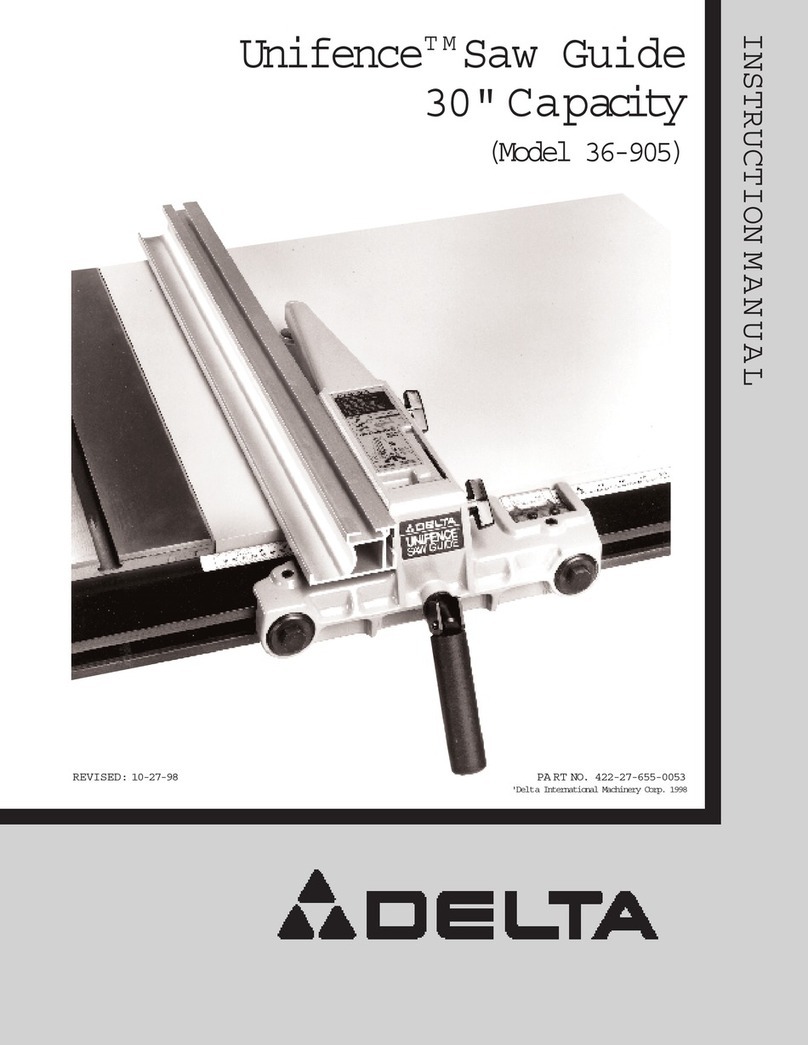
Delta
Delta Unifence 36-905 User manual

Delta
Delta 36-220 User manual

Delta
Delta 36-648 User manual
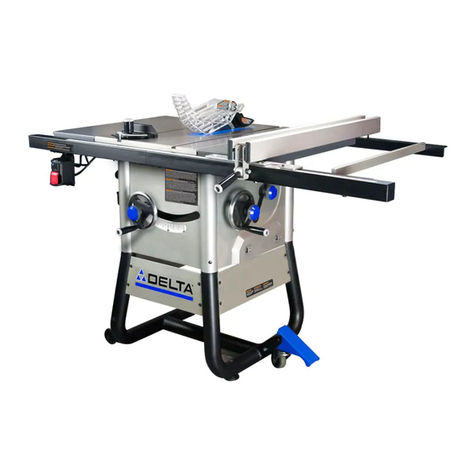
Delta
Delta 36-725 User manual
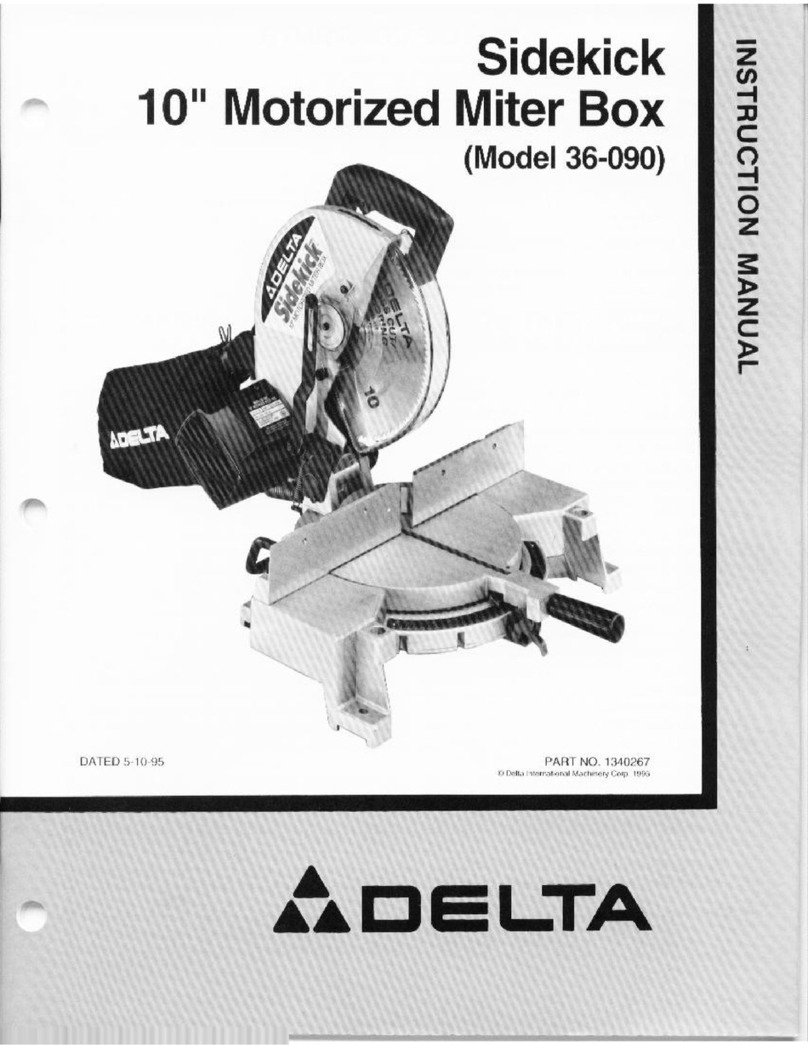
Delta
Delta SIDEKICK 10" MOTORIZED MITRE BOX 36-090 User manual
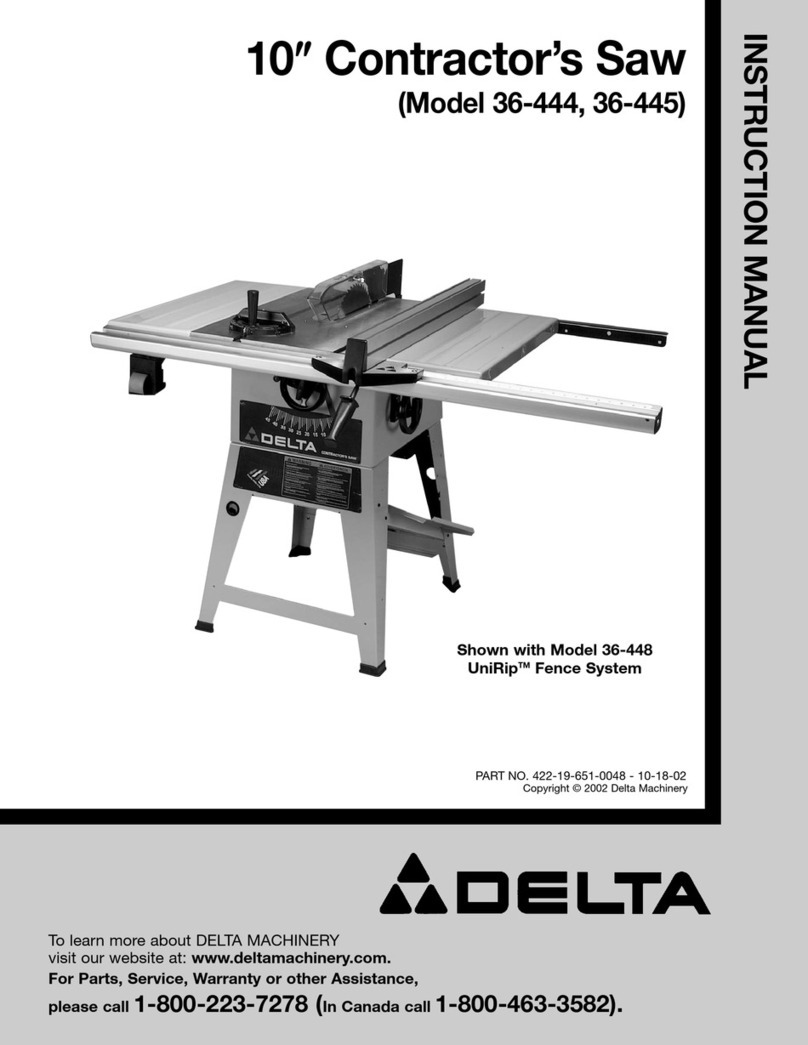
Delta
Delta 36-444 User manual
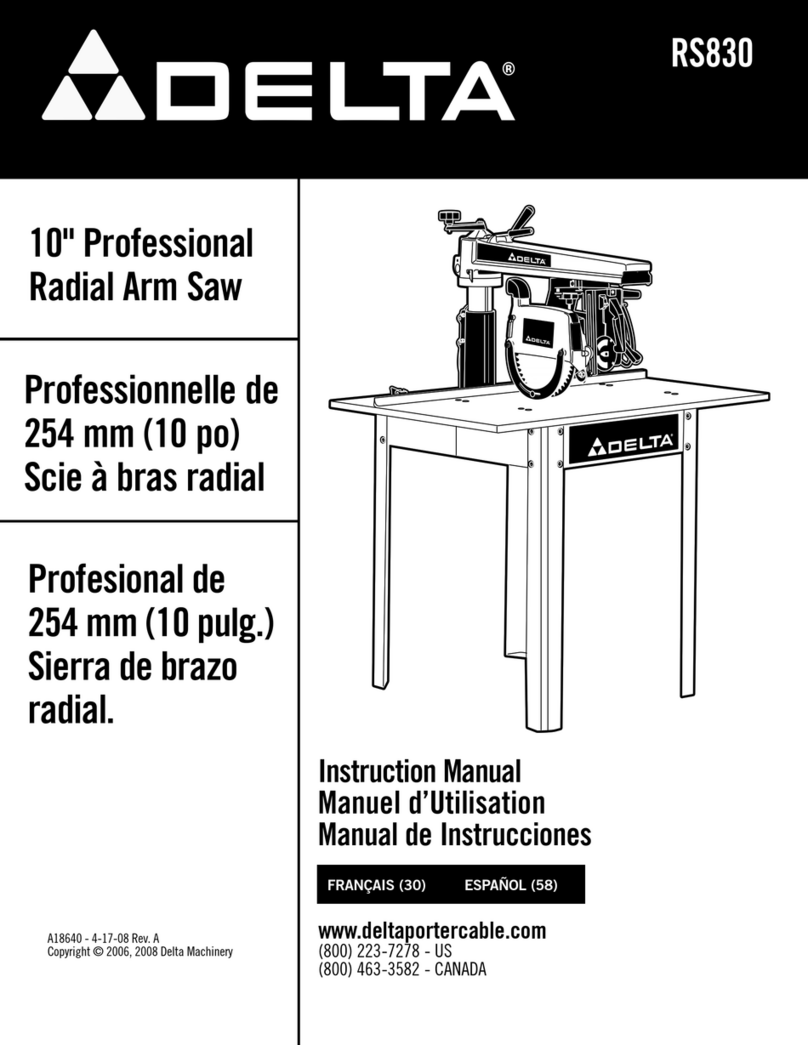
Delta
Delta RS830 User manual

Delta
Delta 36-220 User manual

Delta
Delta 28-190 User manual
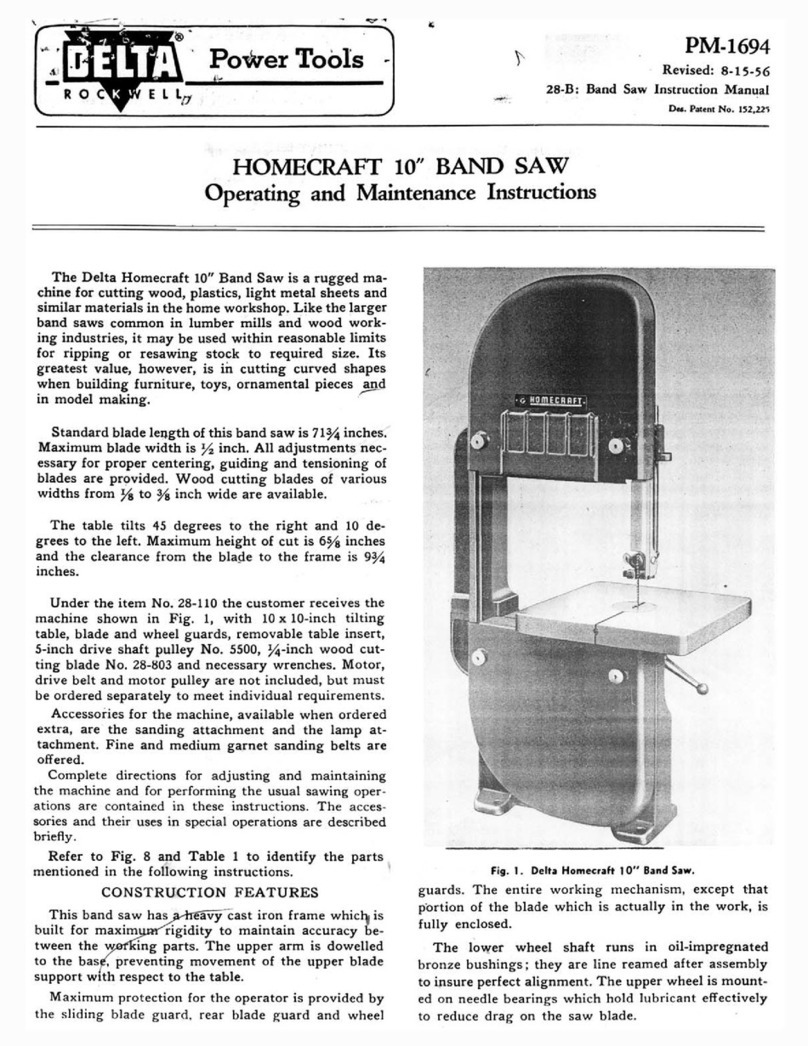
Delta
Delta Homecraft PM-1694 Manual

Delta
Delta ShopMaster MS350 User manual
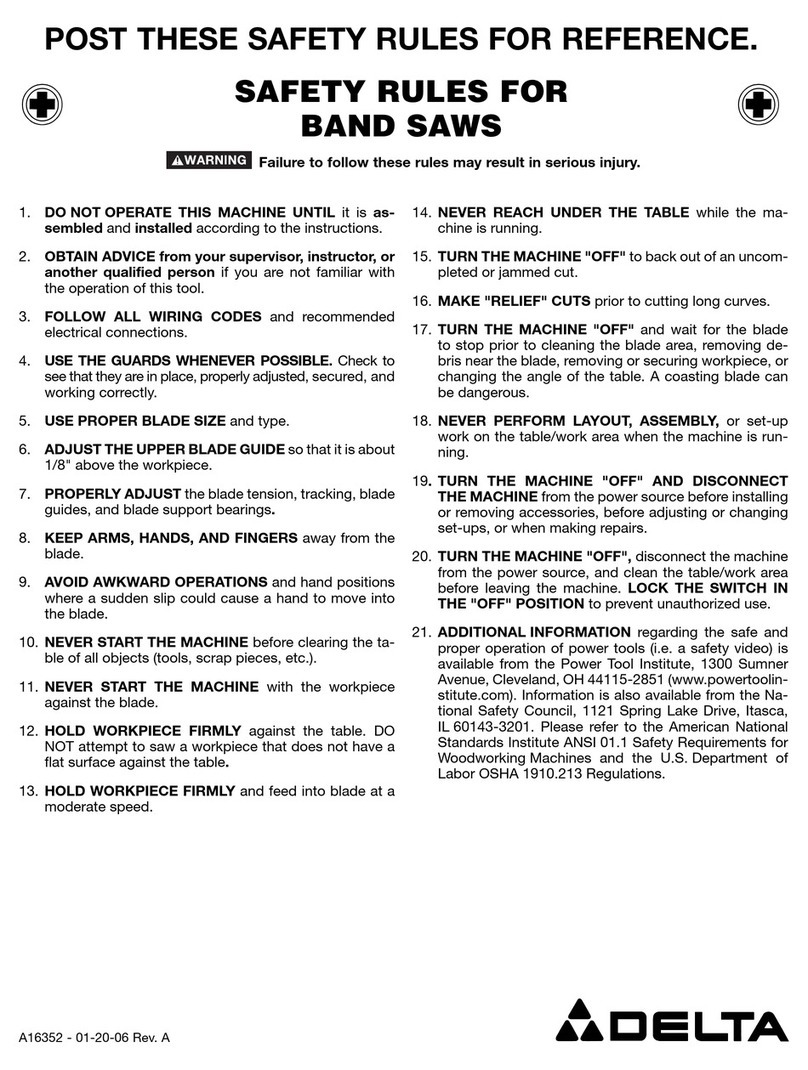
Delta
Delta Band Saws User manual

Delta
Delta 36-6022 User manual
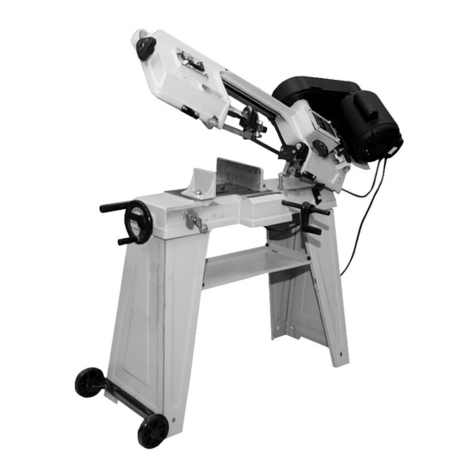
Delta
Delta 20-330 User manual
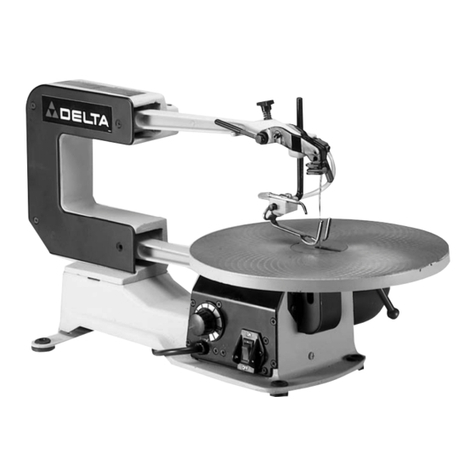
Delta
Delta 40-540 User manual
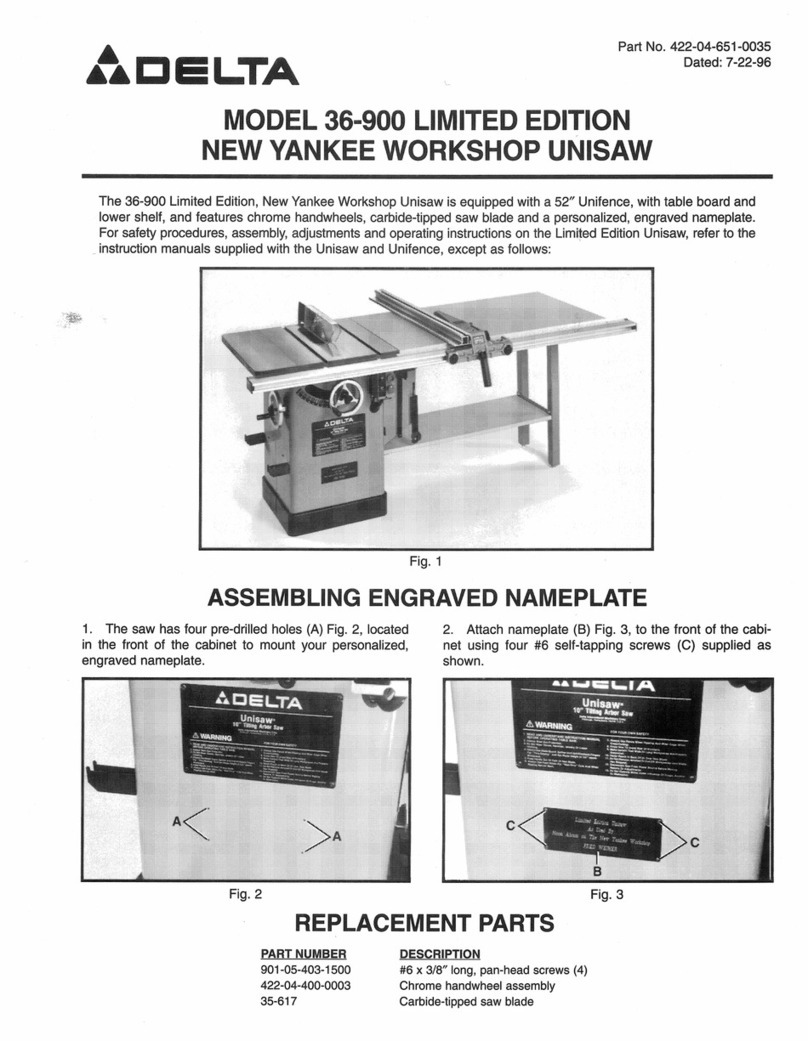
Delta
Delta Unisaw 36-900 User manual
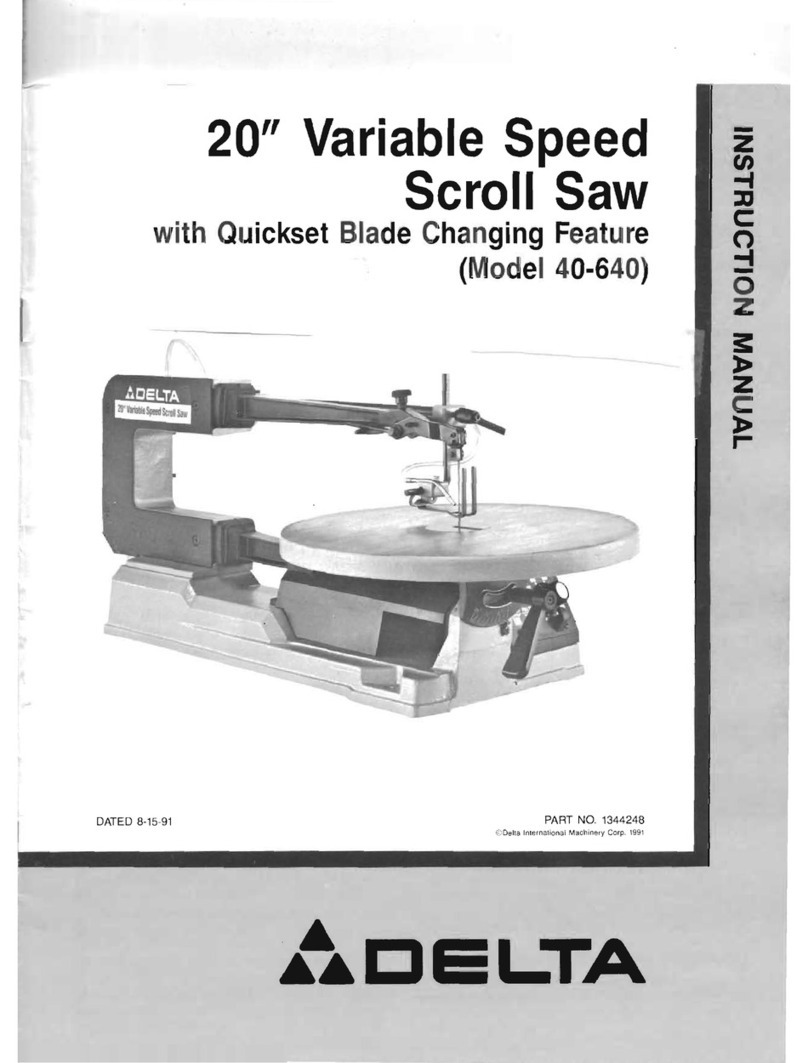
Delta
Delta 40-640 User manual

Delta
Delta 34-444 User manual

Delta
Delta 36-475 User manual
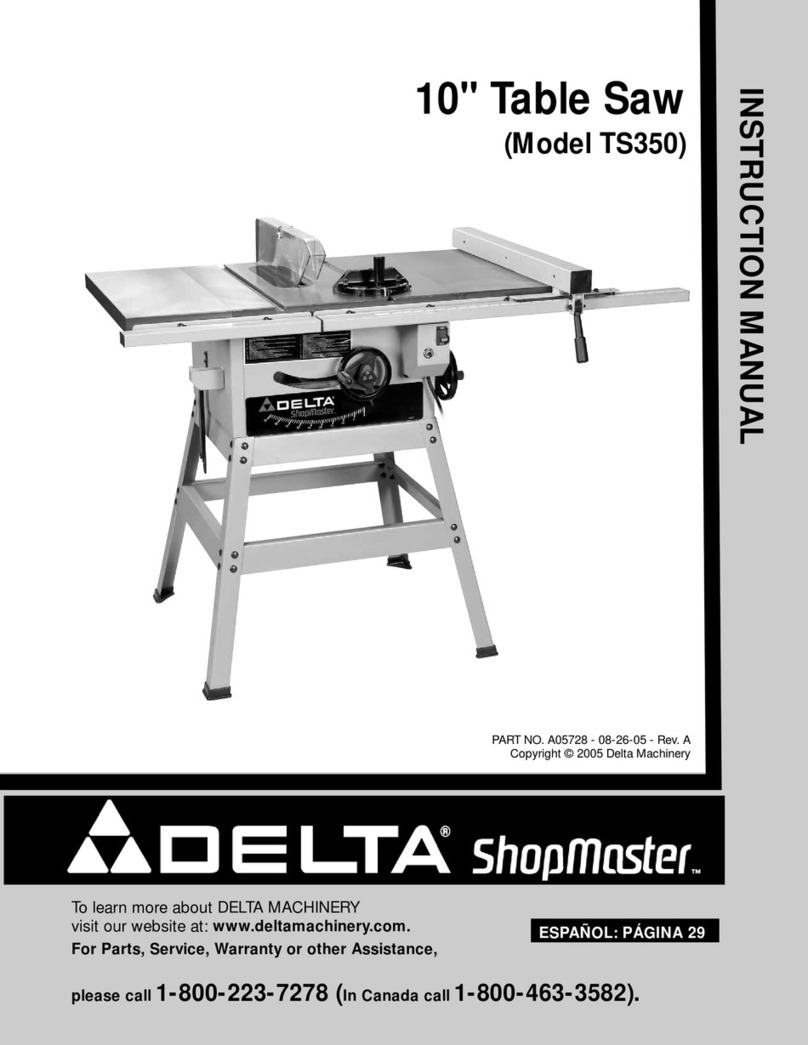
Delta
Delta TS350 User manual
